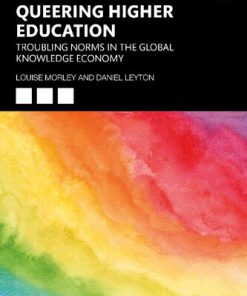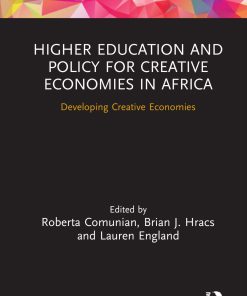The Flipped Approach to Higher Education 1st Edition by Muhammed Sahin, Caroline Fell Kurban ISBN 9781786357434 1786357437
$50.00 Original price was: $50.00.$25.00Current price is: $25.00.
The Flipped Approach to Higher Education 1st Edition by Muhammed Sahin, Caroline Fell Kurban – Ebook PDF Instant Download/Delivery: 9781786357434 ,1786357437
Full download The Flipped Approach to Higher Education 1st Edition after payment

Product details:
ISBN 10: 1786357437
ISBN 13: 9781786357434
Author: Muhammed Sahin, Caroline Fell Kurban
The Flipped Approach to Higher Education 1st Edition Table of contents:
Chapter 1 The Socio-Economic and Socio-Technical Nature of Today’s World and How This Impacts the
1.1. Employment
1.2. Education
1.3. Knowledge, Connectivity, and Cognitive Overload
1.4. What is Needed from Education Today
Chapter 2 Flipped Learning: A Transformative Approach Designed to Meet the Needs of Today’s Knowle
2.1. What is Flipped Learning?
2.2. How Did Flipped Learning Develop?
2.3. How Flipped Learning Meets the Needs of Today’s Knowledge Economies and Societies
Chapter 3 From Current Practice to Future Practice: Making the Decision to Flip
3.1. Introduction
3.2. Moving from Current Practice to Future Practice: How the Need for Change Emerged
3.3. Searching for Future Practice
3.4. The Big Reveal
Chapter 4 Organizational Design and Transformation
4.1. Physical and Geographical Infrastructure
4.2. Human, Social, and Intellectual Capital
4.3. Technological Infrastructure
Chapter 5 Flipped Learning Theory, Policies, and Practices
5.1. Introduction
5.2. Flipped Learning Theories
5.3. Flipped Learning Performance Gaps, Causes, and Interventions
5.4. From Theory to Practice
5.4.1. A Recommended Course Design Process
5.4.2. An Instructional Design Handbook
5.4.3. A Flipped Learning Instructional Design Online Course
5.4.4. A Flipped Learning Instructional Design Best Practice Checklist
5.4.5. Support for Students
5.5. Summary
Chapter 6 Flipped Leadership: Transparency, Vision, Accountability, and Resources
6.1. MEF University Rector, Muhammed Şahin
6.2. Instructors’ Expectations
6.3. Physical Infrastructure
6.4. Real-Life Assessment
6.5. Conclusion
Chapter 7 Supporting Flipped Learning: Digital Pedagogy, Training, and Resources
7.1. CELT, Caroline Fell Kurban
7.1.1. Challenges through the Instructors’ Eyes
7.1.2. Challenges through the Students’ Eyes
7.1.3. Challenges through the Institution’s Eyes: The Need for an Audit
7.1.4. Lessons Learnt from the Audit: How the Process Could be Made More Supportive while Still Hold
7.1.5. Lessons Learnt from Implementing Technological Mandates
7.1.6. Where Next? Strategic Plan for the Rest of the Academic Year
7.2. ITC, Brian Ramey
7.2.1. The Technological Infrastructure Needed for a Flipped Environment
7.2.2. Integrating Digital Resources
7.2.3. Using Data to Effect Change
7.2.4. The Need for a Secure Video Server
7.2.5. Conclusion
7.3. Library Director, Ertuğrul Çiman
7.3.1. The Architecture of a Library in a Digital World
7.3.2. The Successes of Using Digital Materials
7.3.3. The Challenges of Using Digital Materials
7.3.4. Academic Integrity in a Digital World
Chapter 8 Engaging Students in a Flipped Language Learning Environment: Stories from the English Lan
8.1. Director of the School of Foreign Languages, John McKeown
8.1.1. Background and Requirements of MEF ELPP Prior to MEF Opening
8.1.2. Flipped Learning Teacher Training and Development Prior to MEF Opening
8.1.3. Developing a Flipped Learning ELPP Curriculum Prior to MEF Opening
8.1.4. Choosing Resources for a Flipped Program Prior to MEF Opening
8.1.5. Creating an ELPP Assessment Structure Prior to MEF Opening
8.1.6. Creating Resources for the Flip Prior to MEF Opening
8.1.7. Lessons Learnt from the First Year
8.1.7.1. Students are comfortable using technology
8.1.7.2. Assessment weighting
8.1.7.3. Coherence between course books and online consolidation materials
8.1.8. The ELPP Approach in the Second Year
8.1.9. Conclusion
8.2. ELPP Instructor, Joel Compton
Chapter 9 Flipping Language, Literature, and Digital Literacies: Stories from the School of Foreign
9.1. Faculty Academic English Coordinator, Joshua Shannon-Chastain
9.1.1. Approach in Semester One
9.1.2. Approach in Semester Two
9.1.3. Approach in Semester Three
9.1.4. The Results at the End of Semester Three
9.1.5. Looking Forward
9.2. New Media Literacy Skills Elective Course, Daryl Peel
9.2.1. Approach to the First Course
9.2.2. Results at the End of the First Course
9.2.3. Approach to the Second Course
9.2.4. Results at the End of the Second Course
9.2.5. Approach to the Third Course
9.2.6. Conclusion
9.3. Understanding Literature, Understanding Life Elective Course, Eric Beyer and Jonathan Day
9.3.1. Design of the First Course
9.3.2. Design of the Second Course
9.3.3. Comparing the Two Courses
9.3.4. Conclusion
Chapter 10 How the Faculty of Engineering is Developing its Flipped Approach
10.1. Calculus I, Can Fuad Delale
10.2. Approach in the First Semester
10.3. Approach in the Second Semester
10.4. Conclusion
Chapter 11 Creating the Flipped Educators of the Future: Leading by Example in the Faculty of Educat
11.1. Dean of the Faculty of Education, Mustafa Özcan
11.1.1. The University within School Model
11.1.2. Why I Chose MEF University to Implement the University within School Model
11.2. Introduction to Mathematics Teaching Course, Zelha Tun¸c-Pekkan
11.2.1. Developing a Course Framework
11.2.1.1. Videos related to the assigned readings
11.2.1.2. Pre-service teachers’ self-created videos
11.2.1.3. Videos from my previous fifth grade class
11.2.1.4. YouTube videos from mathematics education professor, Jo Boaler, at Stanford University
11.2.2. Lessons Learnt and How These Can Be Addressed
11.3. Calculus, Utkun Aydin
11.3.1. Getting to Understand Flipped Learning
11.3.2. Starting to Flip My Course
11.3.3. Flipped Videos
11.3.4. Flipped Presentations
11.3.5. Flipped Activities
11.4. Conclusion
Chapter 12 Differentiating Flipped Learning Approaches for the Diverse Needs of the Faculty of Econo
12.1. Mathematics for Social Sciences, Murat Öztürk
12.1.1. Aims of the Course
12.1.2. Structure of the Course
12.1.3. Lessons Learnt About The Group
12.1.4. Conclusion
12.2. Digital Resources for Economics and Finance Courses, Nazlı Toraganlı and Levent Güntay
12.2.1. Instructors’ Own Videos
12.2.2. Videos and Test Banks Provided by Publishers
12.2.3. Digital Platforms
12.2.4. Conclusion
Chapter 13 Flipped Learning in Legal Education: A Personal Experience
13.1. Law, Emine Karacaoğlu
13.2. Traditional Teaching Methods on Law Faculties
13.3. Flipped Learning: First Videos, First Classes
13.4. Flipped Learning: Experience in the Second Year
13.5. Conclusion
Chapter 14 How it Emerged that the Approach to Arts, Design, and Architecture Already Contains a Fli
14.1. Architectural Education Overview, Arda İnceoğlu
14.1.1. Course Description and Goals
14.1.2. Organization of the Content
14.1.3. Fall 2014 and Spring 2015 Courses and Results
14.1.4. Fall 2015 Revision and Results
14.1.5. Conclusion
14.2. A Bridge to Dreams, Arda İnceoğlu, Burcu Serdar Köknar, Ahmet Sezgin, Derya Uzal
14.2.1. Design-Build Studio in Architecture Education
14.2.2. The Pedestrian Bridge at AyazaĞa Primary School: Bridge to Dreams
Chapter 15 Flipped Learning through the Eyes of the Students: Tales and Anecdotes
15.1. First Year Mathematics Education Department Student, Mehmet Ali Işık
15.2. Second Year Political Science and International Relations Student, Tarik Ali Sert
15.3. Second Year Political Science and International Relations Student, Nikan Khamisi
Chapter 16 Cultural Aspects Inherent in Flipped Learning
16.1. American Instructor Teaching in a Turkish Flipped Learning Environment, Joel Compton
Chapter 17 Milestones for Success
17.1. Introduction
17.2. Short-Term Milestones for Success: How We Plan to Reach These, and How We will Evaluate the Re
17.2.1. Leadership from the Top
17.2.1.1. Milestone: provide incentives by reinforcing positive performances
17.2.1.2. Milestone: develop an institutional philosophy in order to develop a contemporary assessme
17.2.2. Institutional Commitment and Investment
17.2.2.1. Milestone: allocating more funding for Flipped Learning conferences, memberships, research
17.2.3. Robust and Reliable Infrastructure
17.2.3.1. Milestone: Convert any remaining classrooms in the university into fully functional Flippe
17.2.4. Effective and Available Support for Academic Staff
17.2.4.1. Milestone: effective practices for Flipping large classes will be developed
17.2.4.2. Milestone: provide clear guidelines regarding copyright
17.2.4.3. Milestone: formalizing an instructor development program
17.2.4.4. Milestone: introduce a program for peer observation and collaboration
17.2.5. Ability to Demonstrate the Benefits to the Student and Staff Experience
17.2.5.1. Milestone: provide more information to students about effectively engaging with Flipped co
17.2.6. Evidence-Based Decision-Making and a Continuous Cycle of Improvement
17.2.6.1. Milestone: build capacity and skills in order to enhance evidence-based decision-making
17.2.6.2. Milestone: develop differentiated best practices for Flipped Learning which are specific t
17.2.6.3. Milestone: introduction of more digital platforms
17.3. Looking to the Long Term
17.4. Conclusion
Acknowledgements
References
Index
People also search for The Flipped Approach to Higher Education 1st Edition:
what is the flipped learning model
what are the four pillars of flipped learning
use the flipped classroom model
is flipped classroom effective
are flipped classrooms effective
Tags: Muhammed Sahin, Caroline Fell Kurban, Flipped Approach, Higher Education
You may also like…
Education Studies & Teaching - Education - General & Miscellaneous
Education Studies & Teaching - Higher & Further Education
Uncategorized
Uncategorized
Intellectuals Universities and the State in Western Modern Societies Ron Eyerman (Editor)
Education Studies & Teaching - Higher & Further Education











